Understanding the development of a cat’s coat is both fascinating and practical for cat owners. Kittens are born with a certain type of fur that undergoes substantial changes as they mature. Typically, kittens start with softer, shorter fur which may not fully indicate their adult coat type. Breed and genetics play a critical role in determining when a cat will develop its full coat, with factors such as length, color, and texture being influenced over time.
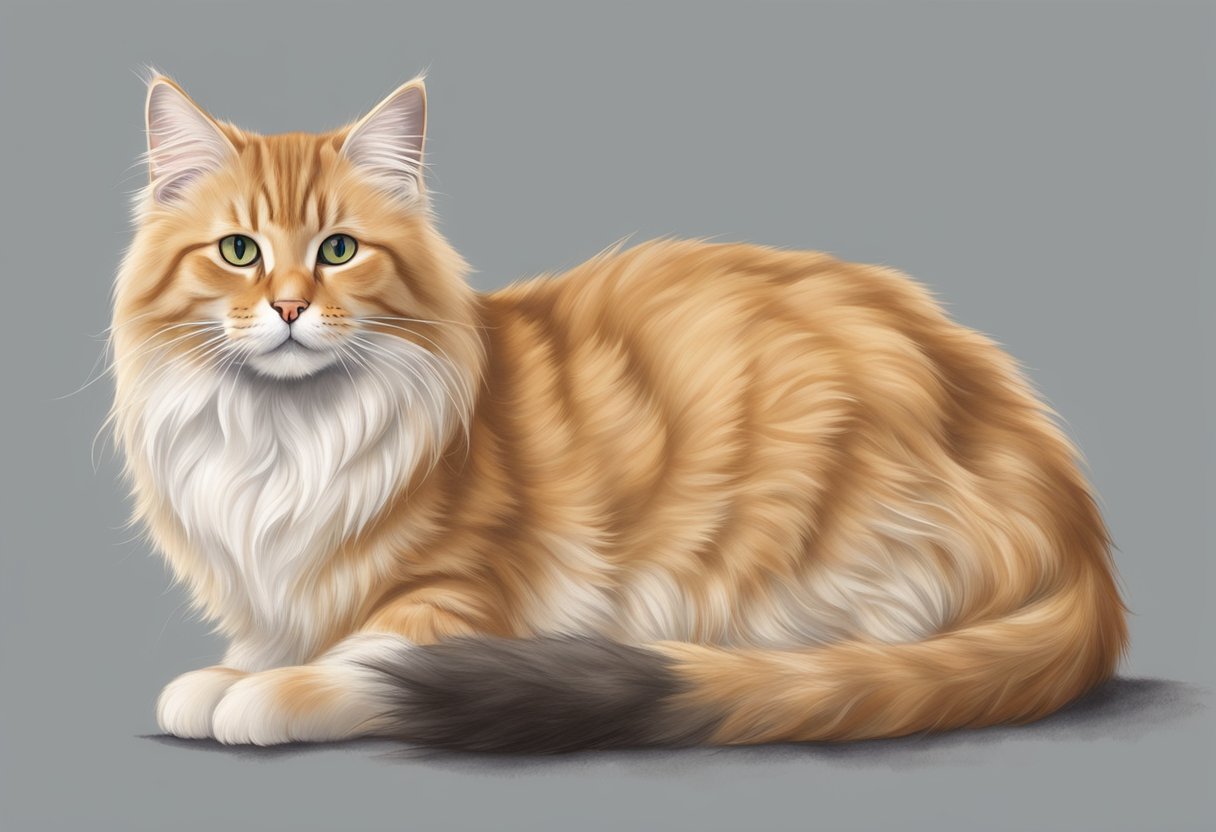
As cats grow, their initial fur is replaced by an adult coat that varies among breeds. For example, long-haired breeds such as the Maine Coon or Persian will have noticeable changes in their fur’s length and thickness as they approach maturity. Most cats reach their full coat development between the ages of 6 months to a year, but some breeds, particularly those with longer hair, may continue to develop their final coat pattern and thickness well into their second year. Environmental factors, nutrition, and grooming practices also significantly influence the health and quality of a cat’s coat throughout their lives.
Key Takeaways
- Cats’ coats evolve from kittenhood to adulthood, influenced by genetics and breed.
- Full coat development generally occurs by one year of age, though some breeds may take longer.
- Proper care, along with environmental factors, plays a significant role in the coat’s health.
Understanding Cat Coats
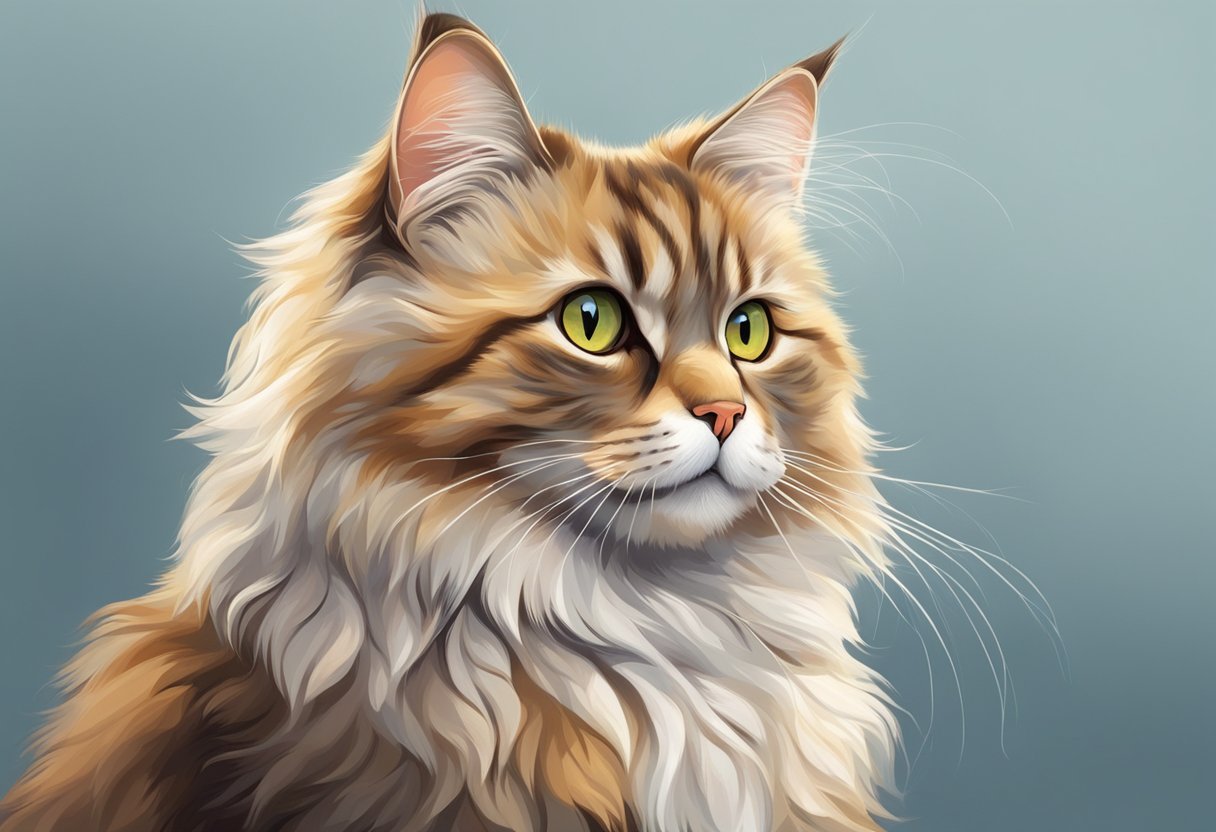
The comprehensive understanding of cat coats involves discerning the intricacies of fur anatomy and the genetic mechanisms behind their development. Insights into fur structure and genetic influence allow for a deeper appreciation of the diversity in feline coat patterns and textures.
Basic Anatomy of Cat Fur
Cat fur is a protective layer that covers the skin, consisting of two main parts: the outer coat and the undercoat. The outer coat, or guard hairs, are the longer hairs that provide the first line of defense against environmental elements. The undercoat consists of shorter, fluffier hairs that offer insulation. Kittens are born with a softer, uniform kitten coat which they shed as they mature into their full adult fur.
Fur length in cats can vary significantly, with some cats sporting long, flowing locks, while others have short fur that requires minimal grooming. This variation contributes to different grooming needs across various cat breeds.
Role of Genetics in Coat Development
Genetics play a pivotal role in determining a cat’s coat color and pattern. Fur color is primarily dictated by two types of melanin: eumelanin, which influences black and brown tones, and phaeomelanin, which results in reds and creams. Genetic information carried by the genes (such as the orange gene and the white spotting gene) and their interactions produce the rich variety of coat colors and patterns seen in cats.
The patterns in cat coats, from stripes to spots, are also influenced by genetic information, specifically the agouti gene. This gene determines whether a cat will have a uniform color or a patterned coat. Additionally, the presence of recessive or dominant genes affects how certain coat traits are expressed. For example, the trait for long hair is recessive and thus requires two copies for this trait to be physically exhibited in the cat’s appearance.
Certain genetic mutations can lead to unique features in cats: polydactyl cats have extra toes; albino cats lack pigmentation entirely due to a genetic mutation; and dilution refers to a mutation that dilutes the fur’s color intensity. Genetics is not only responsible for the appearance of the coat but can also be connected to the gender of the cat, whereby some coat colors and patterns are sex-linked.
Kitten to Adult: Tracking Coat Changes
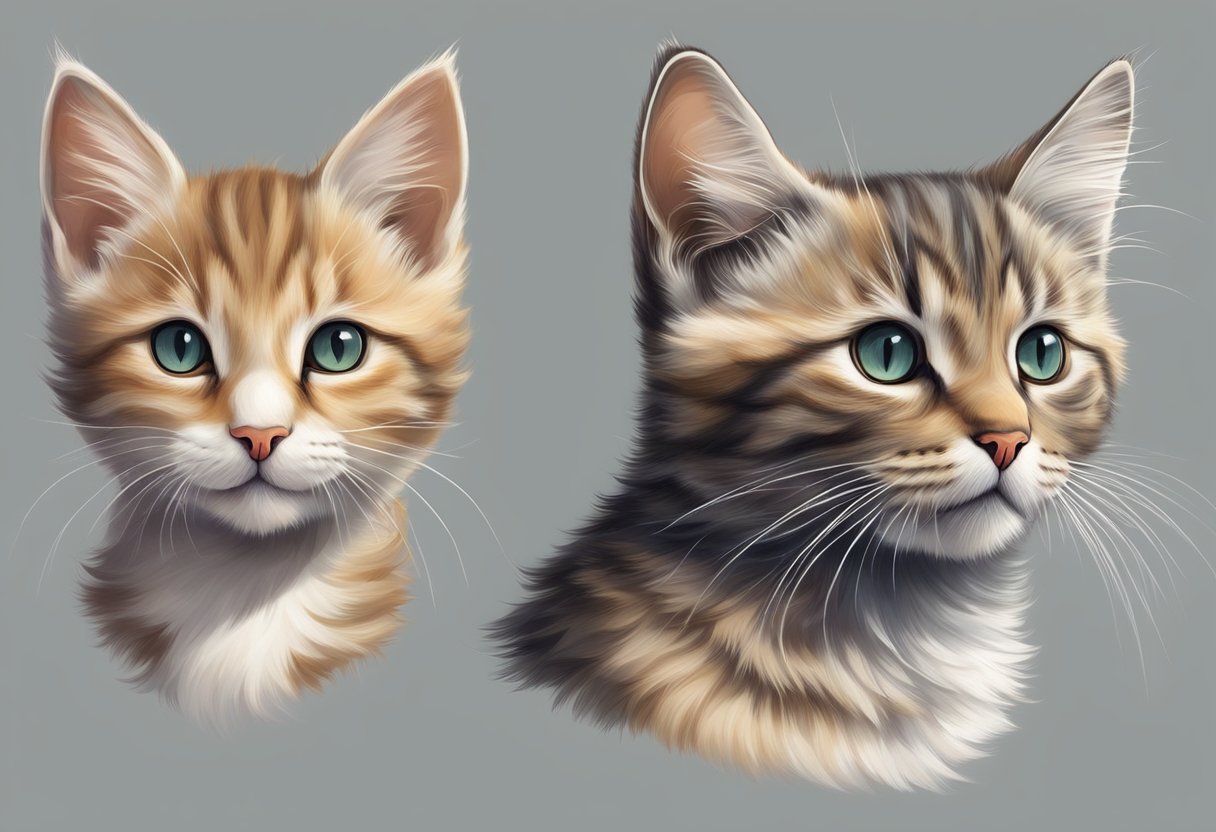
Cats experience several stages of coat development from the soft fuzz of kittenhood to the full, mature fur of adulthood. The changes in their coat are integral not just for their appearance, but also for protection and regulating body heat.
From Birth to Adulthood
Initially, kittens are born with a fine, soft coat that provides minimal insulation. This kitten coat is crucial for keeping them warm, yet, as they grow, their needs change. During the first weeks, the mother cat’s grooming habits serve as the primary care for her litter’s fur. As kittens progress in age, hormonal changes and growth spurts influence coat density, texture, and shedding patterns.
Timeline of Coat Maturity
- Birth to 2 months: Kittens have a downy fur that gradually changes as they approach the 8-week mark.
- 2 to 6 months: Their fur begins to develop its adult texture, although not its full length or thickness. The process wherein these changes occur is sometimes documented through kitten owners’ experiences, shedding light on the variability in fur development.
- 6 to 12 months: A noticeable shift can be seen in the quality of the fur. By the age of one year, most cats will have their adult coat that showcases the definitive length and pattern.
Key to the transition from a kitten coat to an adult one is the onset of secondary hairs that contribute to fur’s overall length and insulation capacity. These secondary hairs grow in around 3-4 months of age with a gradual increase into their first year. Regular grooming becomes increasingly important as cats develop their adult coats to manage shedding and maintain coat health.
Factors Influencing Coat Development
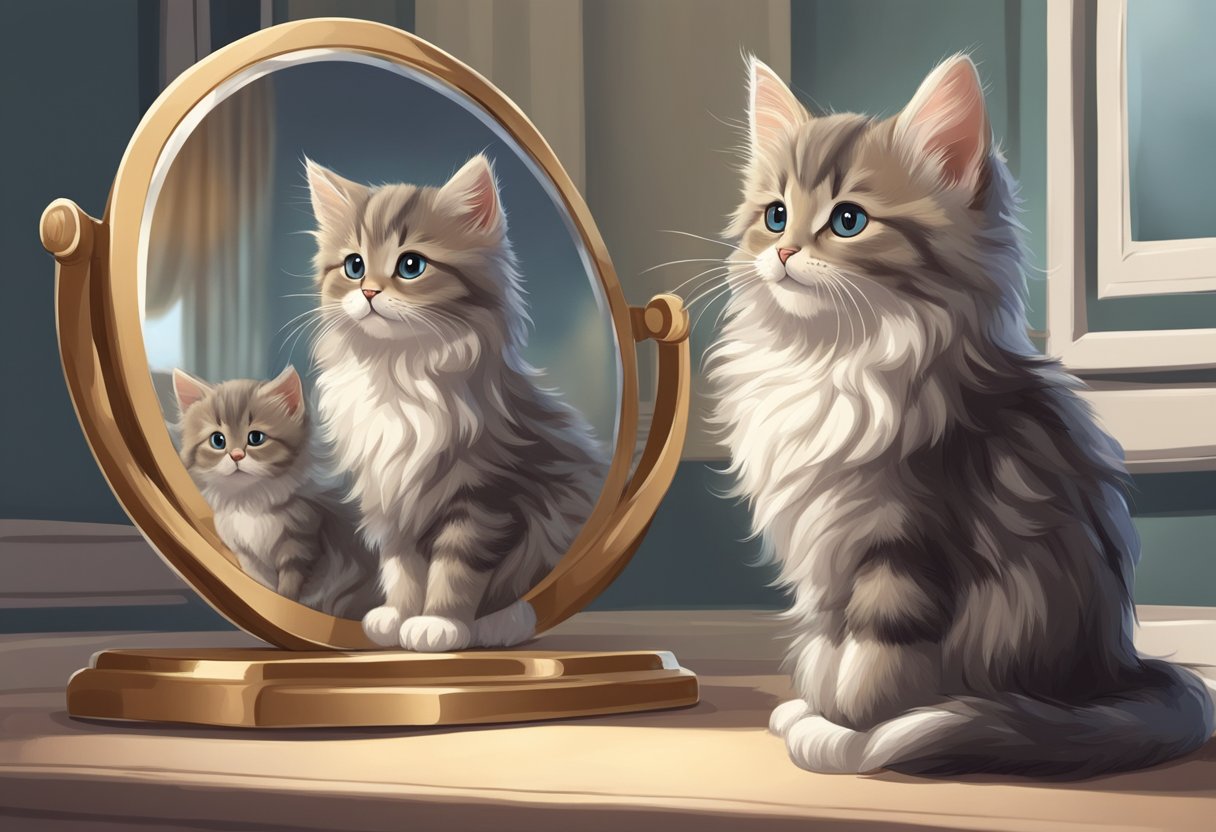
The development of a cat’s coat is a complex process influenced by a variety of factors, including seasonal variations, diet and nutrition, and health and medical conditions. These factors can affect the color, texture, thickness, and shedding patterns of a cat’s fur.
Seasonal Variations
Cats’ coats are highly responsive to changes in temperature and sunlight. In response to colder temperatures, they often develop a thicker winter coat. As the days get shorter and sunlight decreases, this signals the cat’s body to grow a denser coat for winter. Conversely, as temperatures rise and days lengthen, cats commonly experience increased shedding, making way for a lighter coat suited to warmer conditions.
Diet and Nutrition
Proper nutrition is essential in the development of a healthy cat’s coat. Cat food that is rich in essential fatty acids, vitamins, and minerals supports a glossy and strong fur. Adequate energy supplied through diet ensures a cat’s body has the necessary resources for coat maintenance. Deficiencies or imbalances can lead to dull fur, while supplementation may be required for optimal coat health.
Health and Medical Conditions
The overall health of a cat is reflected in its coat. Cats experiencing stress or pain may have lackluster coats. Illnesses, such as diabetes or allergies, can negatively impact coat health. In senior cats, changes in coat condition may signal underlying health issues. It’s crucial to monitor any notable changes in a cat’s coat, as it can be one of the first visible signs of a medical condition.
Breed-Specific Coat Characteristics
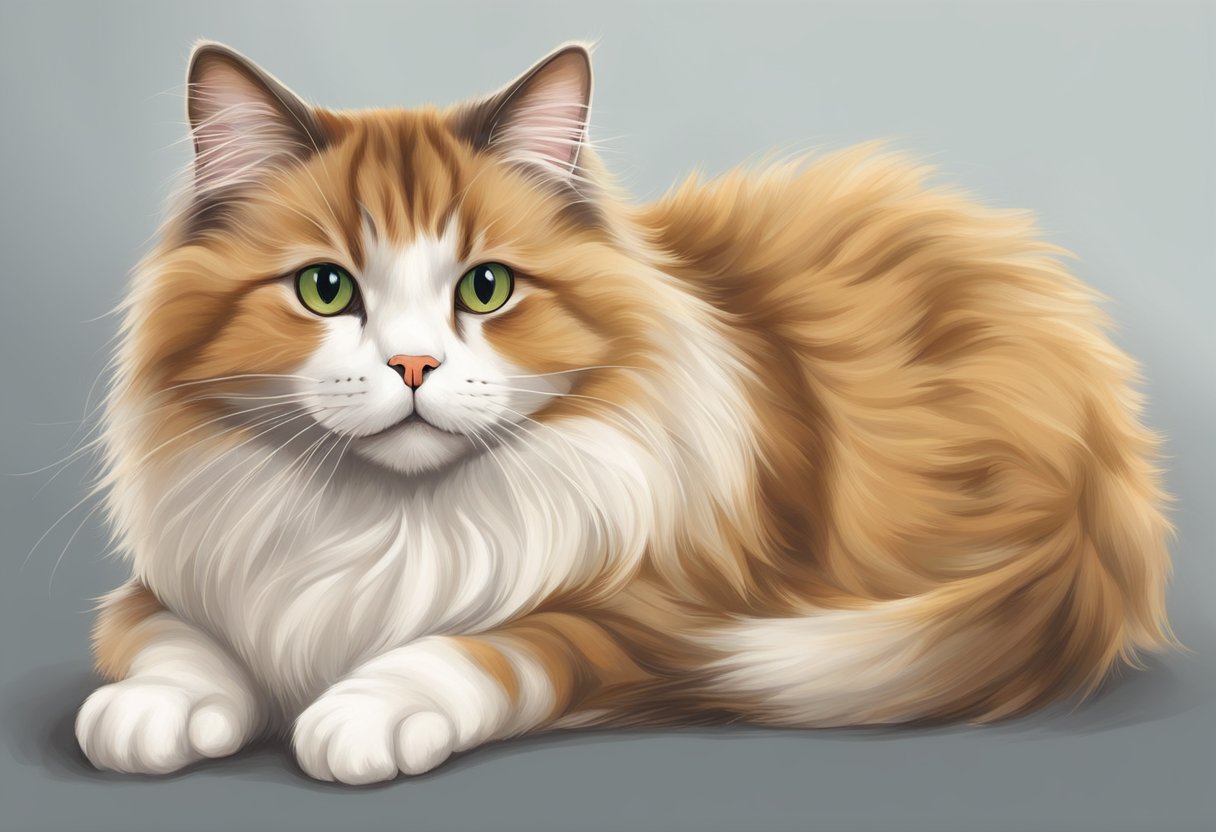
Cats display a vast range of coat characteristics that are often tied to specific breeds, with genetics determining factors such as color, pattern, and length.
Coat Types Across Cat Breeds
Different breeds exhibit distinct coat types that are a significant part of their breed standards. For instance, Siamese cats are known for their short, sleek coats coupled with a colorpoint pattern where their body is lighter in color than their extremities—face, ears, paws, and tail. In contrast, breeds like the Persian exemplify long, luxurious coats that require daily grooming. There are also breeds noted for less common fur attributes, such as the curly coats of the LaPerm or the nearly hairless Sphynx.
Color Patterns and Breed Specifics
When it comes to coat colors and patterns, breed plays a key role in what can be expected. The smoke pattern, for example, is often found in breeds like the Maine Coon, where a white undercoat is deeply tipped with colors such as black, gray, or blue. Calico and tortoiseshell patterns, composed of a mosaic of orange, black, cream, and sometimes white, are predominantly seen in female cats due to the genetic link to the X chromosome. Tabby pattern cats display varieties such as classic tabbies with swirling patterns, mackerel tabbies with narrow stripes, and spotted tabbies. Breeds can also be shaded—a variation where the tips of the fur carry the color, creating a gradient effect that can range from light (orange or cream) to dark (black or blue).
Coat Care and Grooming
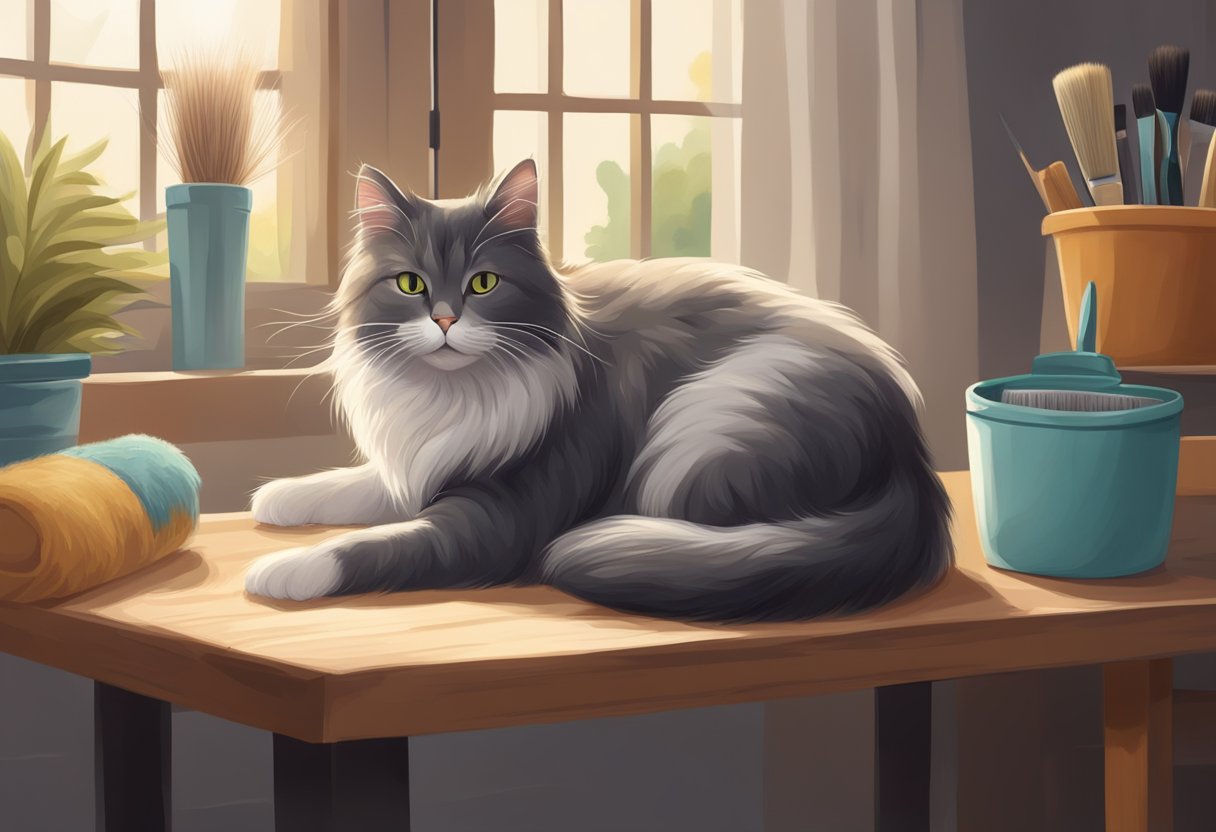
Maintaining a cat’s coat through regular grooming and proper nutrition is vital for their overall health. Not only does it help in reducing shedding, but it also ensures that their undercoat and guard hairs remain in top condition.
The Importance of Regular Grooming
Regular grooming plays a crucial role in the health and well-being of cats. It removes dirt, grease, and dead hair from their coat. This process helps to prevent mats and tangles, especially in long-haired breeds. While a white kitten may show dirt more readily than darker felines, all cats benefit from routine brushing. Brushing also serves as a bonding experience between the owner and the furry friend and allows for the early detection of potential issues like lumps or skin infections.
Best Practices for Coat Maintenance
Coat maintenance is not solely about brushing; it encompasses a broad range of care:
- Brushing: At least once a week is recommended to help distribute natural oils, remove loose fur, and decrease the likelihood of hairballs.
- Shedding: Understanding a cat’s shedding cycle is key. Regularly scheduled grooming sessions can help manage the shedding of the undercoat.
- Nutrition: A well-balanced diet rich in omega-3 and omega-6 fatty acids can promote a healthy coat from the inside out.
- Weight Management: Cats that are overweight may have difficulty grooming themselves, making human intervention more critical.
It is crucial to choose the right grooming tools. Brushes and combs specific to the cat’s coat type will be most effective and comfortable for the cat. For undercoat grooming during high shedding periods, tools like de-shedding implements can significantly reduce the amount of fur a cat may ingest, decreasing the risk of hairballs forming in the digestive tract.
Environmental and Lifestyle Factors
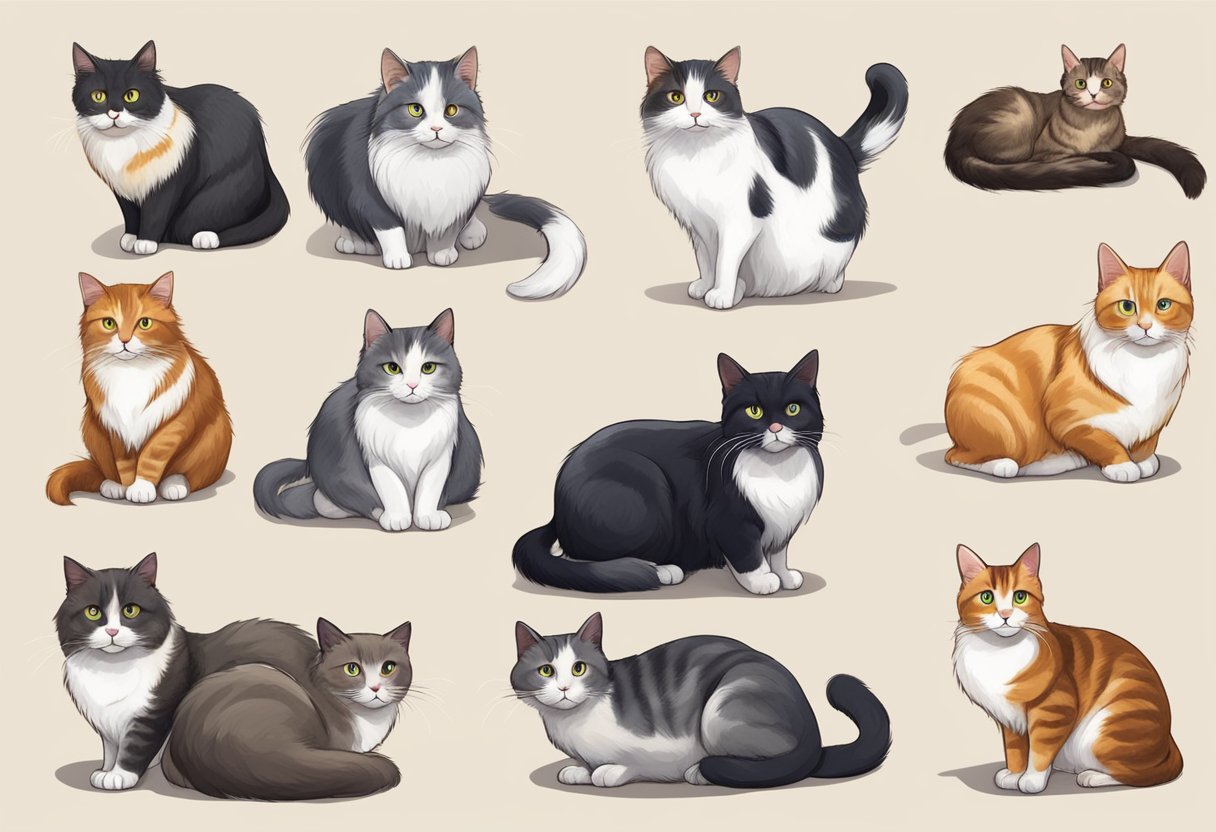
Cats’ coats are significantly influenced by their environment and daily habits. Different living conditions and stress levels can affect the growth and health of their fur.
Impact of Indoor vs Outdoor Living
Indoor cats are typically less exposed to the harsh elements that outdoor cats can encounter, such as cold weather which often triggers the development of a thicker coat. Exposure to sunlight plays a crucial role as well; while indoor cats may bask in sunbeams that filter through windows, they do not experience the same intensity of sunlight as outdoor cats, which can influence their body heat regulation and, subsequently, their coat growth.
Stress and Coat Health
Stress can have a tangible impact on a cat’s coat health. When a cat experiences stress, their grooming behavior may change, which in turn affects the condition of their fur. Adequate grooming is essential for maintaining a shiny and full coat; however, a stressed cat may overgroom to the point of causing hair loss, or undergroom, leading to a dull and matted appearance.
Understanding Coat Color

The full spectrum of a cat’s coat color is a complex interplay of genetics and environmental factors. Crucial elements such as melanin types and their genetic instructions dictate the initial color palette, while variables like sunlight and temperature can influence these hues over time.
Genetics of Coat Color
In cats, coat colors and patterns are determined by multiple genes that govern the distribution and type of melanin in the fur. Melanin exists in two forms: eumelanin (responsible for black, gray, and blue colors) and phaeomelanin (which gives rise to red, orange, and cream colors). For instance, the dilution gene can transform black fur into blue, and red into cream.
The presence of the “white” gene can mask other colors and patterns, leading to completely or partially white cats. The intriguing patterns of tabby cats—mackerel, classic, spotted, and ticked—are caused by specific gene combinations. Calico and tortoiseshell patterns arise from the interaction of the orange gene with random X-chromosome inactivation in females.
Cats inherit their coat colors from their parents, and these traits can be quite predictable. For example, if both parent cats carry the genes for black fur, their offspring will likely be black as well. However, some coat colors can be linked to sex chromosomes, such as the orange gene, located on the X chromosome, explaining why most orange tabbies are male.
Influence of Environment on Color
Environmental factors can also affect a cat’s fur color. Prolonged exposure to sunlight may lighten the coat, while cooler temperature can darken it, especially in breeds with temperature-sensitive fur like the Siamese. A white kitten might develop more vivid patches as it grows, depending on its genetic predispositions and environmental influences.
Albino cats, which lack melanin altogether, are an exception, with their coat color—or lack thereof—entirely dictated by genetics. Their fur and skin do not have pigment, and their eyes reflect light differently, often resulting in a light blue or pinkish color.
It’s important to note that any changes due to environmental factors are usually subtle and might not be immediately obvious to the casual observer.
When to Expect a Full Coat
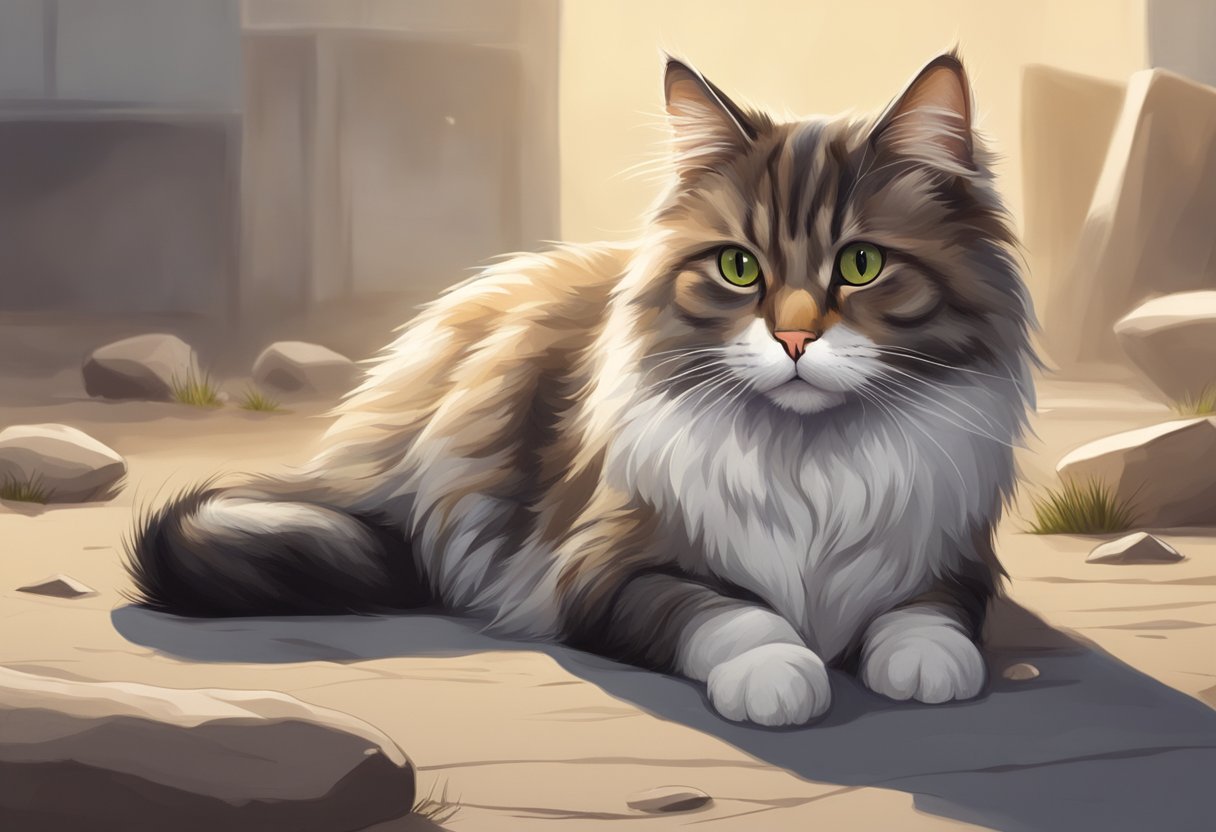
The development of a cat’s fur is a key aspect of its growth and varies across breeds and individual cats. Factors influencing coat development include genetic predispositions and seasonal changes.
Age Milestones for Coat Development
Kittens begin their lives with a softer and less dense coat of fur, commonly known as the “kitten coat.” As they grow, these juvenile coats are gradually replaced by their adult fur. The transition to an adult coat starts around 6 months of age and is generally complete by 12 months. This adult fur is typically denser and may have different color patterns compared to the kitten coat.
Throughout the first year, regular grooming is essential to manage shedding and ensure a healthy coat. During the winter months, a thicker winter coat will develop to provide added insulation against the cold. This heavier coat is usually shed as the weather becomes warmer, resulting in increased shedding during seasonal transitions.
Common Coat Problems and Solutions

Cats may develop coat problems that are often indicative of underlying health issues. Recognizing these issues early can facilitate more effective management and treatment.
Recognizing Signs of Coat Issues
Coat issues in cats can range from mere cosmetic annoyances to indicators of serious health concerns. A healthy cat coat should be smooth and shiny, not brittle or coarse, and skin should be clean without scabs, bumps, or bald patches. Cats usually groom themselves, but excessive shedding, dandruff, or a greasy texture can all signal health problems. Allergies, nutritional deficiencies, stress, or illness can affect a cat’s coat health and may result in symptoms such as continuous scratching, hair loss, or skin irritation. Senior cats are particularly susceptible to skin and coat issues, which could amplify their discomfort and pain.
Approaches to Managing Coat Conditions
Managing a cat’s coat condition involves addressing the root cause. Proper nutrition and diet are fundamental for maintaining a healthy skin and coat. A diet deficient in essential fatty acids can lead to a dull coat and scaling skin, so supplementing with omega-3s is recommended in such cases. Regular grooming helps to distribute natural oils evenly and reduces the chance of matting and tangling.
Addressing environmental stressors can also reduce stress-induced skin and coat problems. When a cat is suffering from allergies, pinpointing the allergen and removing it can alleviate the symptoms. In the event of chronic conditions or when signs point to a potentially fatal illness, consultation with a veterinarian is essential, as they may suggest specific treatments, medications, or dietary adjustments.
If the coat condition is related to an underlying illness such as hyperthyroidism, proper management of the illness is necessary to resolve the coat issues. Owners should also check for parasites, which can cause severe skin and coat problems. In these cases, a vet can recommend, and prescribe, a treatment tailored to the parasite in question.
Coat Changes in Senior Cats
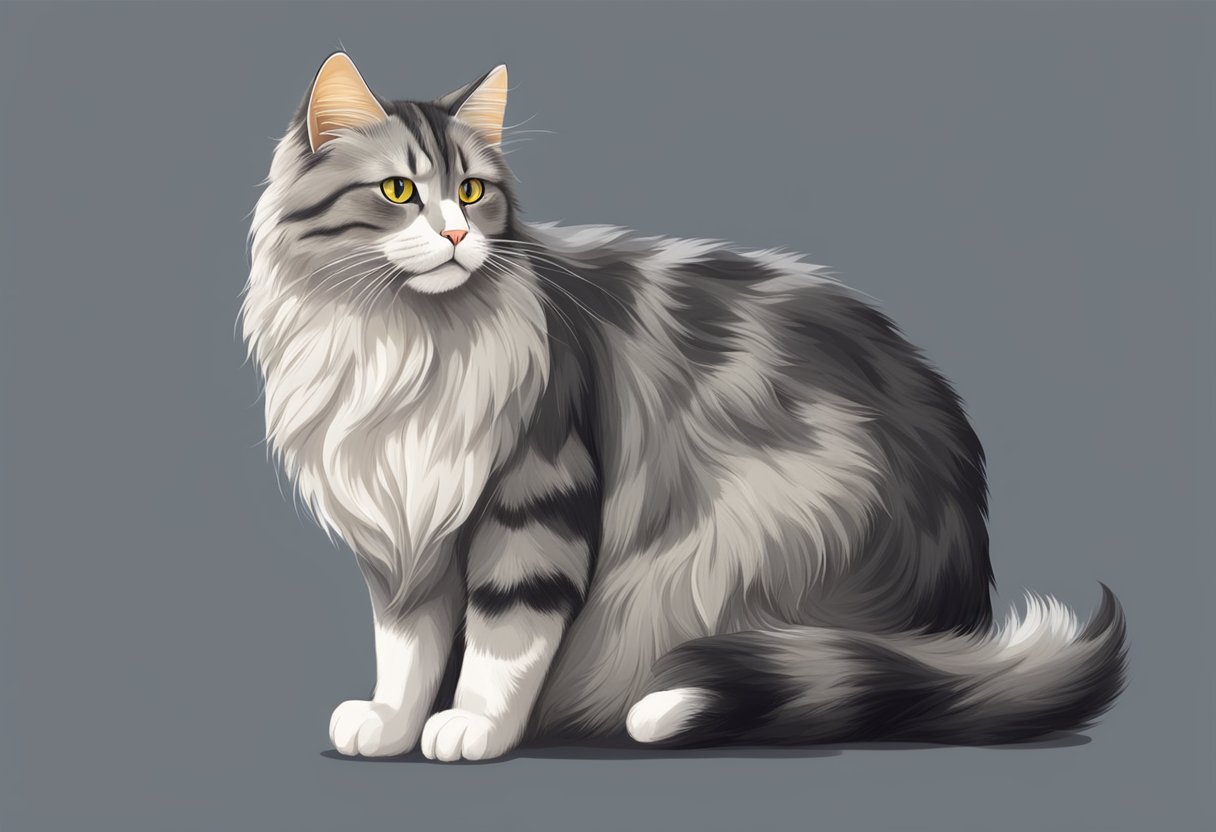
As cats enter their senior years, their coats often undergo noticeable transformations due to various factors that affect their overall wellbeing.
Aging and Its Effects on a Cat’s Coat
Senior cats typically experience a range of coat changes as they age. One significant factor is the decine in grooming habits, leading to a coat that may appear matted or tangled. This decline in self-care can be due to discomfort from arthritis, making it difficult for them to reach certain parts of their body.
The skin of senior cats may also become more sensitive and prone to issues, which can influence the appearance of the fur. This includes a decreased ability for the skin to produce natural oils, resulting in drier and possibly more brittle fur.
Moreover, changes in weight—either weight loss or gain—can impact the condition of a cat’s coat. Weight loss might make their coat feel less plush, whereas weight gain could contribute to an unkempt appearance due to the challenges a cat may face when grooming.
The coloration and pattern of a cat’s fur can also change with age. Decreases in melanocyte activity may contribute to their coat becoming lighter or developing patches of white or gray, similar to humans going gray over time.
Reasons senior cats might stop grooming themselves highlight the importance of assistance from pet owners to help maintain their cat’s coat as these changes occur. Moreover, pet owners are encouraged to help their cats with grooming to prevent matting and to monitor for any skin conditions that might arise during their pet’s senior years.
Conclusion

Cats typically develop their adult coats as they transition from kittenhood. This process varies among different breeds and individual cats. Genetics play a critical role in determining the length and texture of a cat’s coat. Most kittens will start exhibiting their longer adult fur between the ages of 6 to 12 months. However, it’s important to note that environmental factors, as well as nutrition, can influence the growth and health of a cat’s coat.
- Genetics: Key determinant of a cat’s coat length and structure.
- Age: Adult coats usually start to develop around 6 to 12 months.
Certain breeds such as the Selkirk Rex will grow a distinctive adult coat complete with their characteristic features, like a ruff around their neck if longhaired, beginning their first winter as adults. Environmental conditions will also prompt changes in the coat to regulate the cat’s temperature, with thickening or thinning of the fur as needed.
Key factors influencing coat change:
- Breed-specific characteristics
- Age and stage of development
- Environmental adaptation
- Nutrition and overall health
Throughout adulthood, a cat’s coat may continue to undergo changes due to factors such as health, diet, and seasonal shedding. Cat owners should monitor their pets for any significant changes in the coat that could indicate health issues and ensure their feline friends are receiving proper nutrition for maintaining a healthy coat.
Frequently Asked Questions
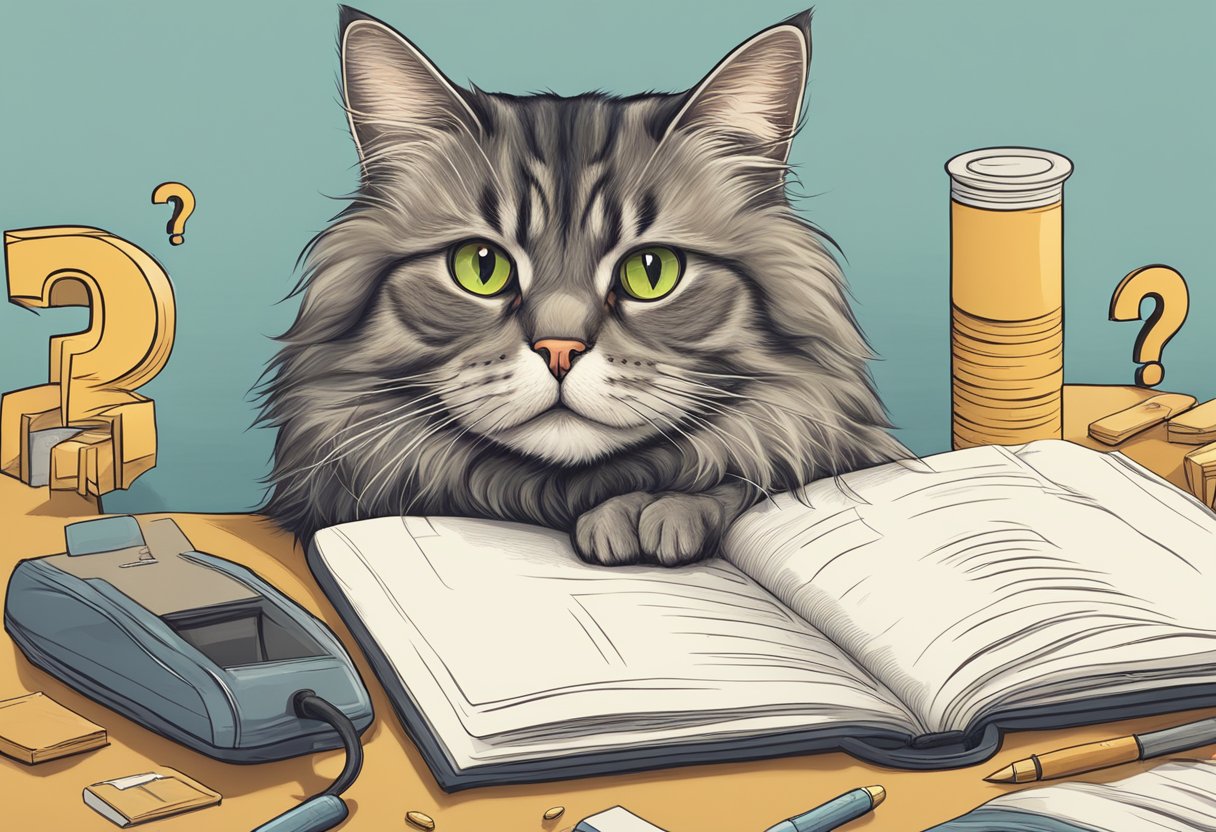
In understanding feline development, it’s important to know about the changes in a cat’s coat from kittenhood to adulthood. Here are some specific answers about their coat development.
At what age do kittens typically shed their baby fur?
Kittens begin to shed their soft, fluffy baby fur, known as the “kitten coat,” as they approach adolescence. This transition usually starts around the age of 6 months and can continue until they are 12 months old, after which they will have their adult coat.
How can one tell if a kitten’s coat will be long or short-haired as an adult?
One method to predict if a kitten will have a long or short-haired coat as an adult is by examining the texture and length of its fur after the initial shedding of the kitten coat. A denser undercoat with longer guard hairs might indicate a long-haired adult coat.
What is a fever coat in kittens, and how does it change over time?
A fever coat in kittens is a discolored coat that they are born with due to the mother’s illness or stress during pregnancy. This temporary condition results in a silvery-grey color, which will gradually shed and be replaced by the kitten’s true color as it matures.
When can you expect kittens to develop their adult coat texture and length?
Typically, by 6 to 12 months of age, kittens will start to develop their adult coat texture and length. The exact time can vary depending on the breed and individual genetics.
How does the shedding pattern of a kitten change as it matures?
The shedding pattern of a kitten will change as it matures, with seasonal shedding becoming more apparent. Growth of a winter coat can start in the autumn, influenced more by light conditions than temperature, leading to more pronounced shedding cycles.
When do kittens usually reach their full size and have a fully developed coat?
Kittens generally reach their full size and have a fully developed coat by the age of 1 year, although some larger breeds may continue to grow and develop until they are 2 years old or older.

